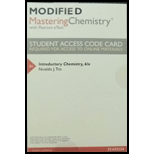
Concept explainers
Interpretation: The property of carbon which is related to its ability to form a large number of compounds is to be determined.
Concept Introduction: Catenation is the property of carbon by which it forms bond with other carbon atoms. It contains four electrons in its valence shell. So, it is difficult to give away four electrons to other element. Thus, it forms covalent bonds. As a result, it is able to form a number of compounds in
Answer to Problem 1SAQ
Correct answer: Option (c), i.e., Carbon has tendency to bond to itself to form rings, chains and branched structures.
Explanation of Solution
Reason for correct option:
Carbon contains four valence electrons in its outer shell. It forms covalent bond by sharing of electrons. Carbon has a tendency to form chain ring and branches. Carbon has the property of catenation. Thus, it forms bond with the other carbon to form number of compounds.
Hence, option (c) is correct.
Reasons for incorrect options:
Option (a) is incorrect because carbon contains four electrons in its valence shell. It cannot donate its electrons to form ionic bonds. So, it is a wrong answer.
Option (b) is incorrect because lower mass does have any effect on formation of bond. So, it is a wrong answer.
Option (d) is incorrect because only one option is correct. So, it is a wrong answer.
Hence, options (a), (b) and (d) are incorrect.
Want to see more full solutions like this?
Chapter 18 Solutions
INTRODUCTORY CHEM.-MOD.MASTERINGCHEM.
 Introductory Chemistry: An Active Learning Approa...ChemistryISBN:9781305079250Author:Mark S. Cracolice, Ed PetersPublisher:Cengage Learning
Introductory Chemistry: An Active Learning Approa...ChemistryISBN:9781305079250Author:Mark S. Cracolice, Ed PetersPublisher:Cengage Learning Chemistry for Today: General, Organic, and Bioche...ChemistryISBN:9781305960060Author:Spencer L. Seager, Michael R. Slabaugh, Maren S. HansenPublisher:Cengage Learning
Chemistry for Today: General, Organic, and Bioche...ChemistryISBN:9781305960060Author:Spencer L. Seager, Michael R. Slabaugh, Maren S. HansenPublisher:Cengage Learning- Chemistry: Matter and ChangeChemistryISBN:9780078746376Author:Dinah Zike, Laurel Dingrando, Nicholas Hainen, Cheryl WistromPublisher:Glencoe/McGraw-Hill School Pub Co

 Chemistry: Principles and ReactionsChemistryISBN:9781305079373Author:William L. Masterton, Cecile N. HurleyPublisher:Cengage Learning
Chemistry: Principles and ReactionsChemistryISBN:9781305079373Author:William L. Masterton, Cecile N. HurleyPublisher:Cengage Learning





